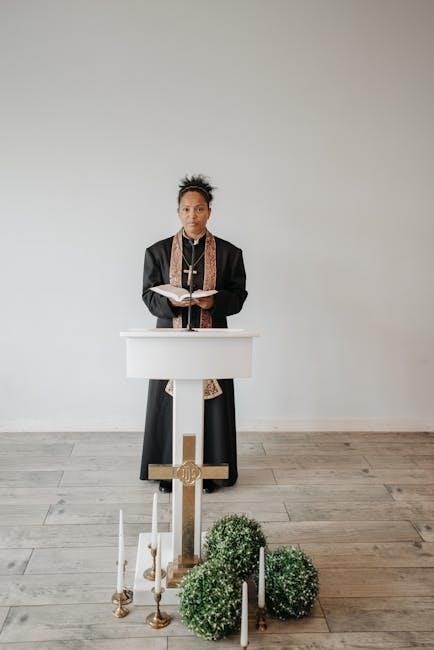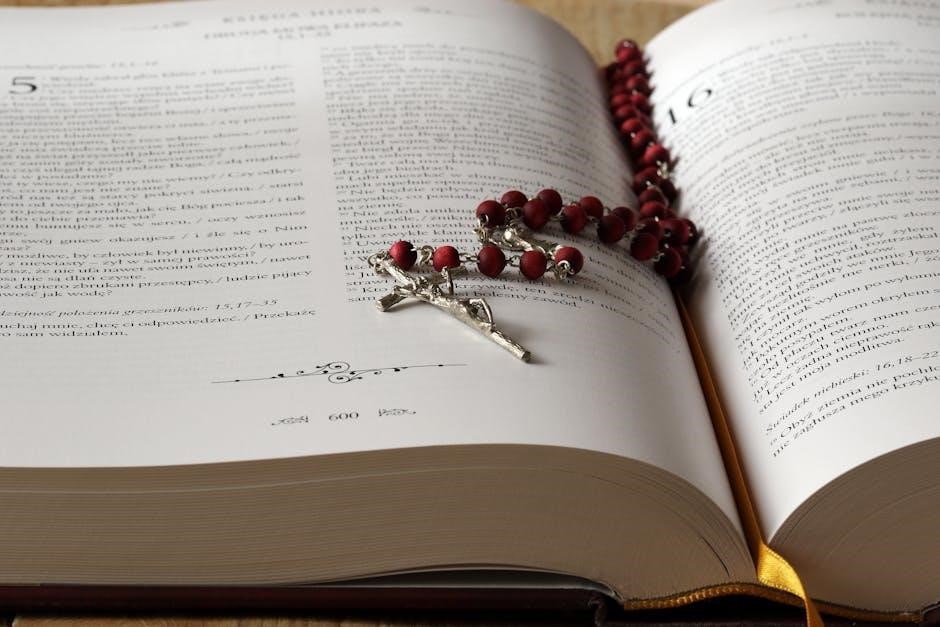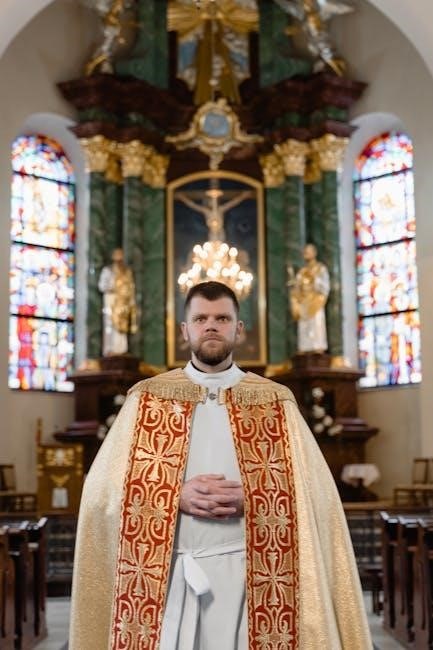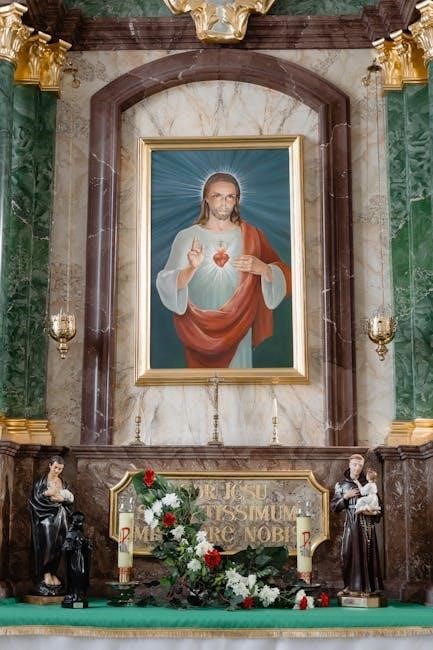The Eucharist, often referred to as “O Sacrament Most Holy,” is a profound expression of Catholic devotion, embodying Christ’s real presence and divine grace.
1.1. Definition and Significance of the Eucharist
The Eucharist, often referred to as “O Sacrament Most Holy,” is a sacred rite in which Christians encounter Christ’s real presence through consecrated bread and wine. It is the central sacrament of the Catholic Church, commemorating the Last Supper where Jesus instituted it as a perpetual memorial of His sacrifice. The Eucharist is both a sacrifice and a meal, fostering unity among believers and nourishing their spiritual lives. Its significance lies in its role as a source of divine grace, strengthening believers and deepening their communion with God and the Church. This sacrament is a profound expression of God’s love and a mystery that transforms participants, drawing them into the life of Christ.
1.2. The Phrase “O Sacrament Most Holy”
The phrase “O Sacrament Most Holy” reflects the profound reverence and awe with which the Eucharist is regarded. It encapsulates the deep devotion and spiritual longing that believers hold for this sacred mystery. Rooted in Catholic tradition, the phrase is often used in prayers and hymns to express the Eucharist’s transcendent nature and its role as a source of divine grace. It emphasizes the belief in Christ’s real presence in the consecrated bread and wine, inviting the faithful to approach the sacrament with humility and adoration. This phrase is a testament to the Eucharist’s enduring significance as a symbol of God’s love and redemption.
1.3. Historical Context of Eucharistic Devotion
Eucharistic devotion has deep historical roots, tracing back to the early Church, where believers revered the sacrament as a direct link to Christ’s sacrifice. The phrase “O Sacrament Most Holy” reflects this timeless veneration, echoing centuries of prayer and adoration. Early Christians celebrated the Eucharist with profound awe, recognizing its connection to the Last Supper. Over the centuries, devotional practices evolved, with the Middle Ages seeing the rise of Eucharistic processions and hymns. The Counter-Reformation further emphasized the sacrament’s centrality, inspiring art, liturgy, and personal spirituality. Today, this phrase continues to resonate, bridging the past and present, as believers worldwide honor the Eucharist as a source of grace and divine encounter.

Theological Foundations
The Eucharist is rooted in the Real Presence of Christ, offering grace and spiritual nourishment. It embodies sacrifice, communion, and divine love, fulfilling “O Sacrament Most Holy.”
2.1. The Real Presence of Christ in the Eucharist
The Real Presence of Christ in the Eucharist is a cornerstone of Catholic belief. Through transubstantiation, bread and wine become Christ’s Body and Blood, offering spiritual nourishment and divine grace. Catholics adore the Eucharist as the ultimate expression of God’s love, a mystery celebrated in the Mass. This belief is deeply rooted in scriptural accounts, such as the Last Supper, where Jesus instituted the sacrament. Devotional practices like Eucharistic adoration reflect the profound reverence for Christ’s Real Presence, which strengthens faith and fosters a deeper union with Him. The Eucharist is thus both a sacrament and a sacrifice, central to Catholic worship and life.
2.2. The Sacrificial Nature of the Mass
The Mass is a sacred sacrifice where Christ’s once-for-all offering on Calvary is re-presented. Through the priest, acting in persona Christi, the Eucharist becomes an act of worship and thanksgiving. Believers participate by offering themselves with Christ, uniting their lives to His sacrifice. This sacrificial nature reflects the depth of God’s love and humanity’s need for redemption. The Mass not only commemorates Christ’s sacrifice but also actualizes its grace, transforming believers and drawing them closer to God. The phrase “O Sacrament Most Holy” underscores the reverence due to this sacred act, which is both a sacrifice and a source of spiritual nourishment for the faithful.
2.3. The Eucharist as a Source of Grace
The Eucharist is a divine wellspring of grace, offering spiritual nourishment and transformation to believers. Through Holy Communion, Christ dwells within the faithful, strengthening their union with Him. This sacrament imparts sanctifying grace, enabling believers to live virtuous lives and grow in holiness. The Eucharist also provides actual graces, assisting in overcoming sin and navigating life’s challenges. By partaking in the Mass, believers are drawn into Christ’s sacrificial love, fostering a deeper relationship with God. The phrase “O Sacrament Most Holy” reflects the profound reverence for this divine gift, which sustains and transforms the soul, equipping believers to live as disciples of Christ in the world.

Historical Development
The Eucharist’s historical development traces back to the Last Supper, with the early Church establishing its practices. Centuries of theological reflection deepened its understanding and celebration.
3.1. The Institution of the Eucharist at the Last Supper
The Last Supper, as narrated in the Gospels, marks the institution of the Eucharist. Jesus, on the night before His Passion, shared a meal with His disciples, transforming bread and wine into His Body and Blood. This act, rooted in Jewish Passover traditions, established the Eucharist as a sacrament of love and sacrifice. The phrase “O Sacrament Most Holy” reflects the profound reverence for this moment, where Christ’s presence becomes real and tangible. The Last Supper not only anticipated Christ’s death and resurrection but also laid the foundation for the Church’s Eucharistic celebrations, forever linking the sacrament to its divine institution.
3.2. Early Church Practices and Teachings
The early Church emphasized the Eucharist as a sacred mystery central to Christian life. Practices included gathering on Sundays for the “breaking of bread,” a tradition rooted in the Last Supper. Teachings from the Apostles and early fathers highlighted the Eucharist as both a sacrifice and a communal meal, fostering unity and spiritual nourishment. The phrase “O Sacrament Most Holy” reflects the reverence with which the Church held this rite. Early writings, such as those of St. Paul and St. Ignatius, underscored the real presence of Christ and the importance of worthy reception. These practices and teachings laid the foundation for the Eucharistic devotion that would flourish in the centuries to come.
3.3. Evolution of Eucharistic Theology Through the Centuries
Eucharistic theology has evolved significantly over the centuries, shaped by theological debates, councils, and spiritual reflections. Early Church Fathers emphasized the real presence of Christ, while medieval scholastics refined concepts like transubstantiation. The Council of Trent reaffirmed Catholic doctrine, countering Reformation views. The phrase “O Sacrament Most Holy” reflects deepening devotion, particularly in theCounter-Reformation era. Modern theology, influenced by Vatican II, highlights the Eucharist as a communal meal and source of grace, bridging the sacred and the lived experience. This evolution underscores the Eucharist’s enduring role as a central mystery of faith, adapting to historical contexts while preserving its essence as a divine encounter.

Scriptural Basis
The Eucharist is rooted in Scripture, notably the Last Supper narratives, John’s Bread of Life discourse, and Paul’s teachings, which form its theological and liturgical foundation.
4.1. The Bread of Life Discourse in John 6

In John 6, Jesus declares Himself the “Bread of Life,” teaching that He is the true bread from heaven, satisfying spiritual hunger forever. The crowd, seeking physical bread, is invited to embrace a deeper spiritual reality. Jesus emphasizes that His flesh is real food and His blood real drink, necessary for eternal life. This discourse is central to Eucharistic theology, as it prefigures the sacrament where believers receive Christ’s body and blood. The Jews’ murmuring and Peter’s confession highlight the divine mystery, underscoring faith’s role in accepting this gift. Jesus’ words foreshadow the Eucharist, where He nourishes souls, promising eternal life to those who partake.
4.2. The Last Supper Narratives in the Gospels
The Last Supper, as recounted in the Gospels of Matthew, Mark, and Luke, is the pivotal event where Jesus instituted the Eucharist. During this meal, Jesus took bread, blessed it, and said, “This is my body,” and gave it to His disciples. Similarly, He took the cup of wine, stating, “This is my blood,” signifying the new covenant. These actions and words are central to the Eucharistic mystery, establishing it as a memorial of His sacrifice. John’s Gospel emphasizes Jesus’ act of washing the disciples’ feet, highlighting the Eucharist’s connection to love and service. The narratives underscore the Eucharist’s role in worship, community, and spiritual nourishment, fulfilling His command to “do this in memory of me.”
4.3. Pauline Teachings on the Eucharist
St. Paul’s writings profoundly illuminate the Eucharist, emphasizing its sacrificial and communal dimensions. In 1 Corinthians 10:16-17, he affirms the Eucharist as participation in Christ’s body and blood, uniting believers in one bread. He recounts the institution of the Eucharist in 1 Corinthians 11:23-25, stressing its connection to Christ’s death and resurrection. Paul underscores the Eucharist as a covenantal act, symbolizing reconciliation and unity. His teachings highlight the Eucharist’s role in forming the Church as one body, with Christ as its head. Moreover, Paul warns against unworthy reception, urging believers to examine themselves before partaking, ensuring reverence and gratitude for this sacred gift.
Personal Spiritual Practices
Personal spiritual practices, such as preparation for Holy Communion, prayers of adoration, and fasting, deepen devotion to the Eucharist, fostering a profound connection with Christ’s sacrifice and grace.
5.1. Preparing for Holy Communion
Preparing for Holy Communion involves spiritual reflection, prayer, and examination of conscience to ensure a worthy reception of the sacrament. Many Catholics pray the “O Sacrament Most Holy” devotion, expressing deep reverence and adoration for Christ’s presence in the Eucharist. Fasting for at least one hour before Communion is a common practice, symbolizing sacrifice and readiness to receive God’s grace. Additionally, attending reconciliation and engaging in acts of charity are encouraged to purify the heart and mind. This preparation fosters a deeper connection with Christ, allowing the individual to fully participate in the sacred ritual and embrace the transformative power of the Eucharist.
5.2. Prayers of Adoration and Thanksgiving
Prayers of adoration and thanksgiving are integral to deepening one’s relationship with Christ in the Eucharist. Many devotees recite the “O Sacrament Most Holy” prayer, expressing profound reverence and gratitude for Christ’s presence in the Eucharist. These prayers often reflect a heartfelt acknowledgment of God’s love and the transformative grace received through Communion. They also serve as a means to express humility, joy, and surrender to God’s will. By incorporating such prayers into daily life, believers cultivate a spirit of thanksgiving and adoration, fostering a deeper connection with the divine. This practice enriches both personal and communal worship, emphasizing the Eucharist’s role as a source of spiritual renewal and strength.
5.3. The Role of Fasting and Abstinence
Fasting and abstinence are sacred practices that prepare the soul for the Eucharist, fostering humility and devotion. The Eucharistic fast, typically one hour before Communion, cleanses the heart and mind, allowing for a deeper union with Christ. Abstinence from certain indulgences reflects self-denial and surrender to God’s will. These disciplines cultivate spiritual awareness, helping believers approach the sacrament with reverence and gratitude. By embracing such practices, individuals honor the sacredness of the Eucharist and align their lives with its transformative power, drawing closer to Christ and strengthening their faith.

Communal Worship and the Mass
The Mass unites believers in communal worship, fostering unity through shared prayer and sacrifice. It is a celebration of divine love, transforming hearts and lives.
6;1. The Structure of the Eucharistic Liturgy
The Eucharistic liturgy is a sacred ritual divided into distinct parts, each carrying profound spiritual significance. It begins with the Introductory Rites, which include the Sign of the Cross, penitential acts, and the Gloria. This is followed by the Liturgy of the Word, featuring biblical readings, a homily, and the Creed. The Liturgy of the Eucharist commences with the preparation of gifts, leading to the Eucharistic Prayer, where the bread and wine are consecrated into Christ’s Body and Blood. The Communion Rite follows, where the faithful receive the Sacrament. Finally, the Mass concludes with the Closing Rites, including the final blessing and dismissal.
6.2. The Role of the Priesthood in the Sacrament
The priesthood holds a vital role in the Eucharist, as priests act in persona Christi, consecrating the bread and wine into Christ’s Body and Blood. Through their sacramental authority, they fulfill Christ’s command to “do this in memory of me.” Priests lead the liturgical celebration, ensuring the integrity of the rites and prayers. They also serve as spiritual guides, helping the faithful deepen their understanding and devotion. The priest’s role is essential for the valid celebration of the Mass, as their consecration transforms the elements, making Christ’s sacrifice present anew for the congregation. Their ministry is a sacred trust, enabling the faithful to encounter Christ in the Eucharist.

6.3. The Importance of Active Participation
Active participation in the Eucharist is essential for a deeper spiritual experience. It involves more than just physical presence; it requires engagement through prayer, singing, and responsive participation in the liturgy. The congregation is called to unite with the priest in offering the sacrifice, fostering a sense of community and shared worship. Active participation helps believers internalize the sacrament’s meaning, drawing them closer to Christ. It also strengthens faith and devotion, enabling individuals to live out the Eucharistic mystery in their daily lives. By fully engaging in the Mass, the faithful honor the sacrament and deepen their spiritual transformation, embodying the call to worship “in spirit and truth.”

Devotional Practices
Eucharistic adoration, rosary meditations, and visits to the Blessed Sacrament foster devotion to the Eucharist, deepening one’s connection to Christ’s presence and grace.
7.1. Eucharistic Adoration and Benediction
Eucharistic adoration is a devotional practice where Catholics reverence the Blessed Sacrament, acknowledging Christ’s real presence. It often includes silent prayer, reflection, and hymns, fostering a deep spiritual connection. Benediction, a solemn blessing with the Eucharist, concludes adoration, emphasizing divine worship. This practice strengthens faith, inspires gratitude, and nurtures a personal relationship with Christ, as believers pray, “O Sacrament Most Holy.” It also encourages communal devotion, uniting the faithful in awe of God’s love and grace, reflected in the Eucharist’s transformative power.
7.2. The Rosary and Eucharistic Meditation
The rosary, a traditional Catholic prayer, complements Eucharistic meditation by fostering contemplation on the life of Christ. Reflecting on the mysteries, especially the Institution of the Eucharist, deepens devotion. Praying the rosary while meditating on the Blessed Sacrament unites believers with Christ’s sacrifice and love. This practice encourages gratitude for the gift of the Eucharist and strengthens spiritual connection. Many pray, “O Sacrament Most Holy,” during adoration, expressing reverence. This combination of prayer and meditation enriches faith, offering a meaningful way to honor Christ’s presence in the Eucharist and live a Eucharistic lifestyle, as inspired by the rosary’s timeless devotion.
7.3. The Practice of Visiting the Blessed Sacrament
Visiting the Blessed Sacrament is a deeply cherished devotional practice, fostering intimacy with Christ. Catholics often spend time in silent prayer before the Eucharist, expressing gratitude and seeking guidance. This practice, rooted in the belief in the Real Presence, Strengthens faith and offers spiritual renewal. Many pray, “O Sacrament Most Holy,” during these visits, reflecting on Christ’s love and sacrifice. The Eucharist’s transformative power is often highlighted, as it nurtures a deeper commitment to living a Eucharistic lifestyle. This devotion encourages believers to seek solace and grace in the Sacrament, fostering a profound connection with God in their daily lives and spiritual journeys.
The Sacrament in Everyday Life
The Eucharist inspires gratitude and prayer, transforming daily actions into spiritual offerings. It strengthens believers, fostering love and service, making “O Sacrament Most Holy” a heartfelt expression of devotion.
8.1. Living a Eucharistic Lifestyle
Living a Eucharistic lifestyle means embracing the sacrament’s transformative power in daily life. It involves gratitude, prayer, and service, fostering a deep connection to Christ. Through acts of love and humility, believers reflect the Eucharist’s grace, turning ordinary moments into sacred encounters. This lifestyle encourages mindfulness of God’s presence, inspiring joy and selflessness. The phrase “O Sacrament Most Holy” becomes a heartfelt expression of devotion, guiding believers to live as vessels of Christ’s love. By integrating the Eucharist’s teachings, individuals cultivate compassion, forgiveness, and unity, embodying the sacrament’s spirit in their words and actions. This way of life is both a gift and a calling, rooted in faith and lived with profound reverence.
8.2. The Eucharist as a Source of Strength
The Eucharist is a profound source of strength for believers, offering spiritual nourishment and comfort in times of need. Through the Real Presence of Christ, it provides solace and renewal, enabling individuals to face life’s challenges with courage. Many turn to the sacrament during difficult moments, finding peace and clarity. The phrase “O Sacrament Most Holy” reflects this reliance on the Eucharist as a divine gift. By partaking in Holy Communion, believers experience a deep sense of unity with God, which strengthens their faith and resilience. This sacramental encounter inspires hope and perseverance, reminding them of Christ’s enduring love and support in all circumstances.
8.3. Bringing the Sacrament to the Sick and Homebound
Bringing the Eucharist to the sick and homebound is a profound act of compassion and spiritual care. Many Catholics find strength in the phrase “O Sacrament Most Holy” when ministering to those unable to attend Mass. Eucharistic ministers are trained to bring the consecrated host to those in need, ensuring they remain connected to the Church and Christ’s presence. This practice emphasizes the sacrament’s role in healing and consolation, offering spiritual nourishment to those who cannot participate in communal worship. It also highlights the unity of the faithful, as the Eucharist bridges the gap between the gathered community and those who are absent due to illness or infirmity.

Challenges and Misconceptions
The Eucharist faces misconceptions, such as viewing it as merely symbolic. Addressing these through catechesis and emphasizing its divine nature is crucial for fostering deeper faith and understanding.
9.1. Common Misunderstandings About the Eucharist
One of the most prevalent misunderstandings about the Eucharist is the belief that it is merely a symbolic representation of Christ’s body and blood. Many do not fully grasp the doctrine of transubstantiation, which teaches that the bread and wine become Christ’s real presence. Additionally, some view the Eucharist as a “rite of passage” rather than a sacrament of divine grace. These misconceptions often stem from a lack of catechetical instruction or cultural influences that downplay its spiritual significance. Addressing these misunderstandings requires a deeper exploration of Scripture, tradition, and the teachings of the Church. Prayer and reflection can also illuminate the Eucharist’s true meaning.
9.2. Addressing Doubts and Questions
Addressing doubts about the Eucharist begins with prayer and personal reflection, seeking clarity through faith and Scripture. Many questions arise from misunderstandings of Church teachings, such as the nature of Christ’s presence. Catechesis plays a vital role in dispelling confusion, emphasizing the Eucharist as both a sacrifice and a sacrament. Encouraging dialogue with spiritual leaders or through devotional practices, like adoration, can deepen understanding. The Holy Spirit, as a teacher, guides believers to discern the truth. Ultimately, faith requires surrender to God’s mysteries, trusting in His promises revealed through the Eucharist. Patience and openness to grace are essential in resolving doubts and fostering a deeper connection to the sacrament.
9.3. The Role of Catechesis in Eucharistic Understanding
Catechesis is crucial for fostering a deep understanding of the Eucharist, serving as the foundation for spiritual growth and devotion; Through systematic instruction, it clarifies the sacrament’s theological dimensions, such as the Real Presence and its sacrificial nature. Catechesis also addresses common misconceptions, ensuring that the faithful grasp the liturgy’s significance and their active role within it. By integrating Scripture, Tradition, and Church teachings, catechesis nurtures a holistic appreciation of the Eucharist. It equips believers to articulate their faith confidently and live it authentically, transforming their participation in the Mass into a profound encounter with Christ. This educational process is essential for sustaining and enriching Eucharistic devotion across generations.

The Sacrament in Modern Times
The Eucharist remains a vital source of spiritual nourishment in contemporary life, fostering unity and grace amidst diverse challenges. Vatican II’s teachings continue to inspire renewal and active participation in the liturgy, emphasizing the sacrament’s universal call to holiness and Communion with God and one another.
10.1. The Eucharist in Contemporary Spirituality
The Eucharist remains a cornerstone of contemporary spirituality, offering a deepening of one’s personal relationship with God and fostering a sense of community. In today’s fast-paced world, the sacrament provides a space for reflection, gratitude, and spiritual growth. Many find solace in the Eucharist as a source of grace, enabling them to navigate life’s challenges with faith and hope. The phrase “O Sacrament Most Holy” reflects a devotion that transcends time, resonating with believers seeking meaning and connection. By partaking in the Eucharist, individuals experience a profound encounter with Christ, which inspires transformative living and a commitment to serving others.
10.2. The Impact of Vatican II on Eucharistic Theology
Vatican II profoundly shaped Eucharistic theology, emphasizing the Mass as a communal act of worship and the source of Christian life. The council’s Constitution on the Sacred Liturgy highlighted the Eucharist as the “summit and source” of ecclesial life, fostering a renewed focus on active participation. It also stressed the real presence of Christ and the sacrificial nature of the Mass, while promoting liturgical reforms to enhance understanding and devotion. The phrase “O Sacrament Most Holy” reflects this deepened appreciation for the Eucharist as a gift of grace and transformation. Vatican II’s teachings continue to inspire a vibrant, communal spirituality centered on the sacrament.
10.3. The Role of the Laity in Eucharistic Ministry
The laity play a vital role in Eucharistic ministry, enriching the Church’s sacramental life through active participation. Vatican II emphasized their involvement in liturgical and devotional practices, fostering a deeper connection to the Eucharist. Lay ministers assist priests, lead prayers, and distribute Communion, especially to the sick and homebound. Their role extends to educating others and promoting Eucharistic devotion, ensuring the sacrament’s transformative power is accessible to all. By engaging in these ministries, the laity embody the phrase “O Sacrament Most Holy,” living out their faith in service and worship, and strengthening the communal bond centered on the Eucharist.



